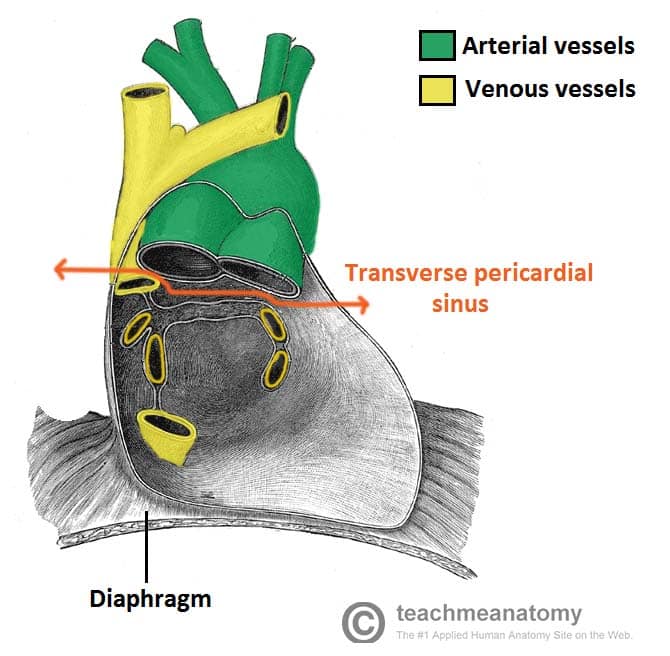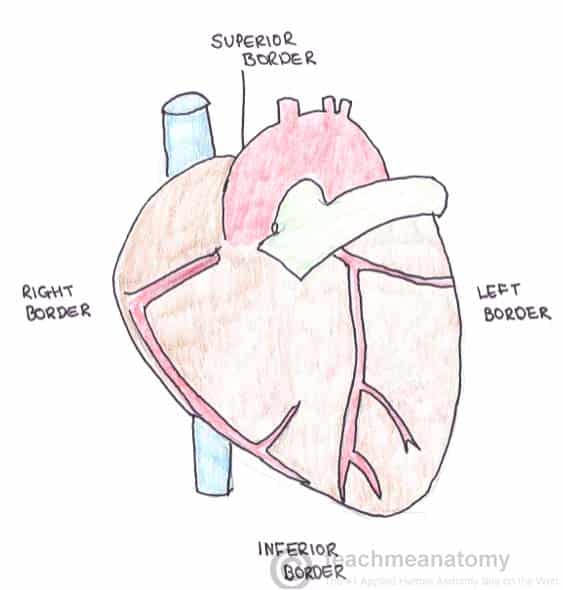The heart is a hollow muscular pump which lies in the middle mediastinum.
It has a complex pyramidal shape – with several different borders and surfaces. The external surfaces are marked by grooves, known as sulci.
In this article, we shall look at the orientation, surfaces and borders of the heart.
Orientation and Surfaces
The shape of the heart can be described as a “pyramid which has fallen over“. The apex of this pyramid points in an anteroinferior direction.
In the anatomical position, the heart has five surfaces – each formed by the different chambers of the heart:
- Anterior (or sternocostal) – Right ventricle.
- Posterior (base of the pyramid) – Left atrium.
- Inferior (or diaphragmatic) – Left and right ventricles.
- Right pulmonary – Right atrium.
- Left pulmonary – Left ventricle.
Borders
Separating the surfaces of the heart are its borders. There are four main borders of the heart:
- Right border – Right atrium
- Inferior border – Left ventricle and right ventricle
- Left border – Left ventricle (and some of the left atrium)
- Superior border – Right and left atrium and the great vessels
Sulci of the Heart
The heart is divided internally into four main chambers. These divisions create grooves on the external surface of the heart – known as sulci.
There are three main sulci:
- Coronary sulcus (atrioventricular groove) – circles around the heart and represents the separation of the atria from the ventricles.
- It contains the right coronary artery, circumflex branch of the left coronary artery, small cardiac vein and coronary sinus
- Anterior interventricular sulcus – located on the anterior surface of the heart and represents the separation of the left and right ventricle.
- It contains the anterior interventricular artery (also known as the left anterior descending artery) and great cardiac vein.
- Posterior interventricular sulcus – located on the posterior surface of the heart and represents the separation of the left and right ventricle.
- It contains the posterior interventricular artery and the middle cardiac vein.
Pericardial Sinuses
The pericardial sinuses are not the same as ‘anatomical sinuses’ (such as the paranasal sinuses). They are passageways formed the unique way in which the pericardium folds around the great vessels.
- The oblique pericardial sinus is a blind ending passageway located on the posterior surface of the heart.
- The transverse pericardial sinus is found superiorly on the heart. It can be used in coronary artery bypass grafting – see below.
Clinical Relevance: Transverse Pericardial Sinus
The location of the transverse pericardial sinus is:
- Posterior to the ascending aorta and pulmonary trunk.
- Anterior to the superior vena cava.
- Superior to the left atrium.
In this position, the transverse pericardial sinus separates the arterial vessels (aorta, pulmonary trunk) and the venous vessels (superior vena cava, pulmonary veins) of the heart.
This can be used to identify and subsequently ligate (to tie off) the arteries of the heart during coronary artery bypass grafting.

Fig 2 – The transverse pericardial sinus, separating the major arteries and veins of the heart.
